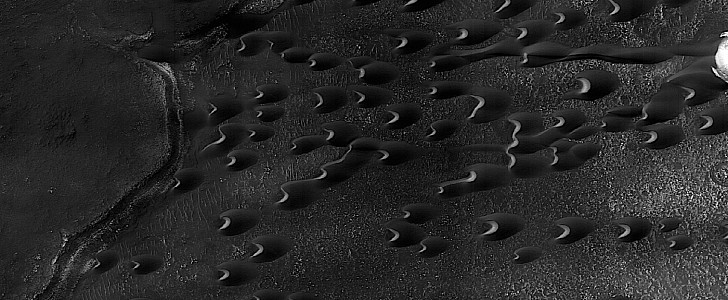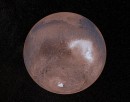Driven by some primordial instinct only they can understand, creatures here on Earth are known to move from place to place in search of whatever that instinct tells them to find. Thanks to the endless footage captured over the years, we know all too well how a massive animal migration looks like. And it looks weirdly similar to this thing here.
A superficial glance at the main image of this pic might have you believe you’re looking at some kind of animals migrating for whatever reason over a vast plain. Then you learn you’re looking at a photo of Mars.
Like in many other occasions, this is only an illusion fueled by our brains trying to make sense of things. Sure, this is a photo of Mars, but it does not show a large flock of some alien creatures, but the omnipresent sand dunes.
The image was captured back in 2017 by the HiRISE camera from an altitude of 252 km (157 miles). It’s the planet’s Southern Highlands we’re looking at, which is, in essence, a very large place, occupying two-thirds of the planet.
Somehow acknowledging their similarity with living creatures, scientists from NASA and the University of Arizona call such large collections of dunes “populations,” and say the Hellespontus region shown here “features numerous collections of dark, dune formations that collect both within depressions such as craters, and among extra-crater plain areas.”
The 5 km-across (3.1 miles) image shows the middle portion of a large dune field. The weird shape of each of the dunes is given by their crescent-shaped tips, and because of them, they’re called barchan. We have barchan dunes here on Earth as well, and we know they come to be as the result of wind coming mostly from the same direction.
The Martian location is also dotted with seif dunes, which are in essence dunes with a narrow, long ridge that makes them look like an Arabic sword.
Like in many other occasions, this is only an illusion fueled by our brains trying to make sense of things. Sure, this is a photo of Mars, but it does not show a large flock of some alien creatures, but the omnipresent sand dunes.
The image was captured back in 2017 by the HiRISE camera from an altitude of 252 km (157 miles). It’s the planet’s Southern Highlands we’re looking at, which is, in essence, a very large place, occupying two-thirds of the planet.
Somehow acknowledging their similarity with living creatures, scientists from NASA and the University of Arizona call such large collections of dunes “populations,” and say the Hellespontus region shown here “features numerous collections of dark, dune formations that collect both within depressions such as craters, and among extra-crater plain areas.”
The 5 km-across (3.1 miles) image shows the middle portion of a large dune field. The weird shape of each of the dunes is given by their crescent-shaped tips, and because of them, they’re called barchan. We have barchan dunes here on Earth as well, and we know they come to be as the result of wind coming mostly from the same direction.
The Martian location is also dotted with seif dunes, which are in essence dunes with a narrow, long ridge that makes them look like an Arabic sword.






